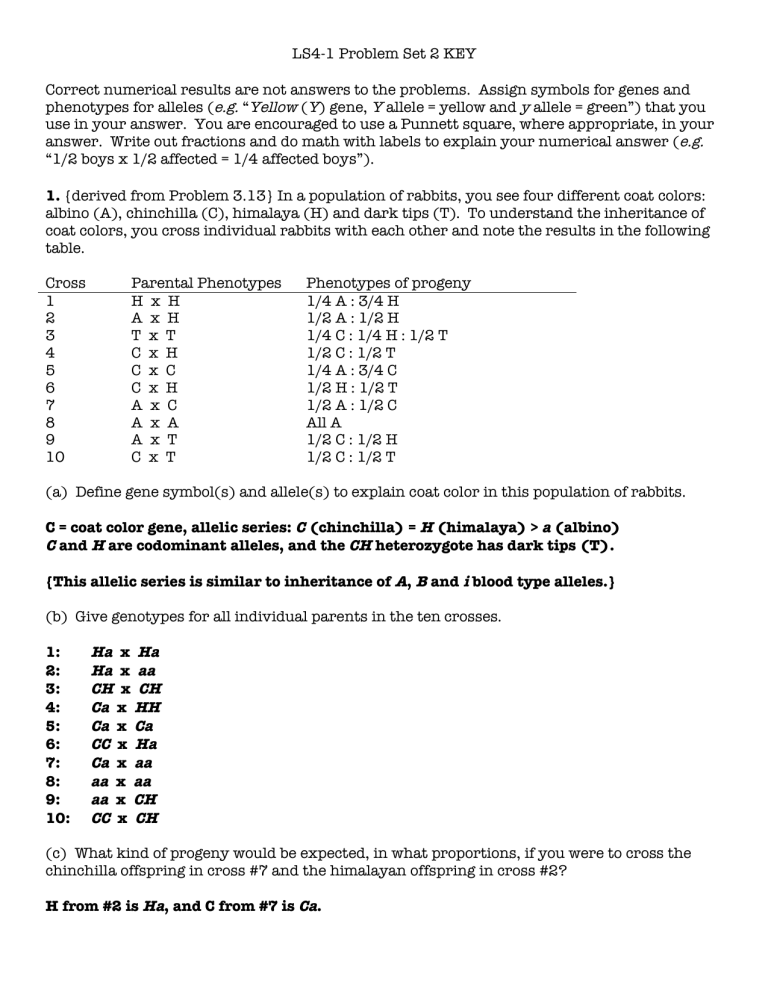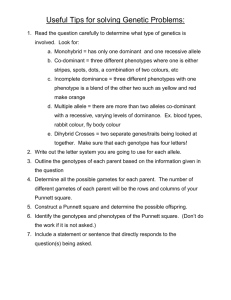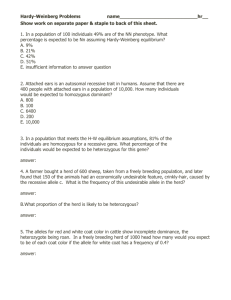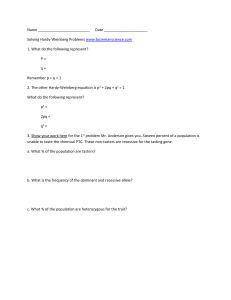Problem Set 2 KEY

LS4-1 Problem Set 2 KEY
Correct numerical results are not answers to the problems. Assign symbols for genes and phenotypes for alleles ( e.g.
“ Yellow ( Y ) gene, Y allele = yellow and y allele = green”) that you use in your answer. You are encouraged to use a Punnett square, where appropriate, in your answer. Write out fractions and do math with labels to explain your numerical answer ( e.g.
“1/2 boys x 1/2 affected = 1/4 affected boys”).
1.
{derived from Problem 3.13} In a population of rabbits, you see four different coat colors: albino (A), chinchilla (C), himalaya (H) and dark tips (T). To understand the inheritance of coat colors, you cross individual rabbits with each other and note the results in the following table.
Cross Parental Phenotypes Phenotypes of progeny
5
6
7
8
1
2
3
4
H x H
A x H
T x T
C x H
C x C
C x H
A x C
A x A
1/4 A : 3/4 H
1/2 A : 1/2 H
1/4 C : 1/4 H : 1/2 T
1/2 C : 1/2 T
1/4 A : 3/4 C
1/2 H : 1/2 T
1/2 A : 1/2 C
All A
9
10
A x T
C x T
1/2 C : 1/2 H
1/2 C : 1/2 T
(a) Define gene symbol(s) and allele(s) to explain coat color in this population of rabbits.
C = coat color gene, allelic series: C (chinchilla) = H (himalaya) > a (albino)
C and H are codominant alleles, and the CH heterozygote has dark tips (T).
{This allelic series is similar to inheritance of A , B and i blood type alleles.}
(b) Give genotypes for all individual parents in the ten crosses.
1: Ha x Ha
2: Ha x aa
3: CH x CH
4: Ca x HH
5: Ca x Ca
6: CC x Ha
7: Ca x aa
8: aa x aa
9: aa x CH
10: CC x CH
(c) What kind of progeny would be expected, in what proportions, if you were to cross the chinchilla offspring in cross #7 and the himalayan offspring in cross #2?
H from #2 is Ha , and C from #7 is Ca .
from cross #7 from
H
C
CH
dark tips
a
Ha
himalayan cross #2
a Ca aa
chinchilla albino
I-1
I-2
I-3
II-1
II-2
II-3
1/4 dark tips : 1/4 chinchilla : 1/4 himalayan : 1/4 albino
2. {derived from Problem 3.7} See the four pedigrees for familial hypercholesterolemia (FH), an inherited trait in humans that results in higher than normal serum cholesterol levels
(measured in milligrams of cholesterol per deciliter of blood [mg/dl]), in the textbook problem
3.7. People with serum cholesterol levels that are roughly twice normal have a 25 times higher frequency of heart attacks than unaffected individuals (yellow symbols). People with serum cholesterol levels three or more times higher than normal have severely blocked arteries and almost always die before they reach the age of 20.
(a) In the four Japanese families, what is the most likely mode of inheritance of FH? Either draw the pedigrees and assign genotypes to all individuals or make a list of all individuals, labeling individuals by generation (starting with “I” for the oldest) and number from left to right (1, 2,…) in each generation and assign genotypes.
FH appears to be a dominant trait, vertical inheritance from parent to child.
A = dominant affected allele, a = recessive unaffected allele
The pedigree would also suggest that the two alleles express incomplete dominance.
Family 1
Person
Family 2
Genotype Person
Family 3
Genotype Person
Family 4
Genotype Person Genotype aa
Aa
Aa
Aa
Aa
AA
I-1
I-2
I-3
I-4
II-1
II-2
II-3
II-4
II-5
II-6
II-7
II-8
II-9
III-1
III-2
III-3
III-4
III-5 aa
Aa aa aa
Aa aa
Aa
Aa
Aa
Aa
Aa
Aa
Aa aa
Aa
AA
Aa
Aa
I-1
I-2
II-1
II-2
Aa
Aa
AA
AA
I-1
I-2
II-1
II-2
II-3
II-4
II-5
II-6
III-1
III-2
III-3
III-4
III-5
III-6
III-7
III-8
III-9 aa
Aa
Aa
AA aa aa aa
AA aa aa aa
Aa
Aa aa aa
Aa
Aa
(b) Are there any individuals that do not fit your hypothesis? What might account for such individuals?
Unaffected I-3 and I-4 in family 2 have three affected offspring, and unaffected I-1 and I-
2 in family 4 have two affected offspring. Possibly the diet of at least two of these unaffected individuals masked the phenotype of FH in parents of these affected offspring. Also, these genotypes could, in fact, express overlapping ranges of serum cholesterol.
(c) Why do individuals in the same phenotypic class (normal or the two affected classes) show a range of levels of serum cholesterol?
Presumably, serum cholesterol is affected by other factors, such as diet and interaction with other genes.
3. {derived from Problem 3.21} A pure-bred black mare was crossed to a pure-bred chestnutcolored stallion and produced a chestnut son and a chestnut daughter. The two F
1
horses were mated to each other several times, and they produced a six offspring with three different coat colors: two bay, two chestnut and two liver.
(a) Could coat color be explained by one gene? by two genes? How? (Assign phenotypes for genotypes of coat color in the described crosses.)
A cross between pure-bred parents would give one heterozygous genotype in the F
1
.
Coat color could not be explained by one gene. The parental cross could be explained as one color ( C ) gene, where the dominant C give chestnut, and the recessive c give black:
CC x cc known.
---> Cc.
The appearance of two more colors in F
2
horses make one coat color gene impossible because the phenotypes of all three possible genotypes – CC , Cc and cc are
A parental cross with two genes with two alleles, one dominant and one recessive, can produce as many as four phenotypic classes in the F
2
. Because there are four colors, each phenotypic class is expressing a different color. Because the F
1
is chestnut, like its parent, the parental cross must have been AA BB (chestnut) x aa bb (black) ---> Aa Bb
(chestnut) .
{The alternative parental cross, AA bb (chestnut) x aa BB (black) to make a dihybrid, would produce an F
1
genotype Aa Bb with a third phenotype.}
9 A– B– (chestnut) : 3 A– bb (bay) : 3 aa B– (liver) : 1 aa bb (black)
In the F2 there are just three colors, not all four possible colors. The missing color, the phenotype (black) for the aa bb genotype, is absent presumably because it represents the rare doubly recessive class.
(b) Mating a bay-colored F
2
horse and a liver-colored F
2
horse produced a black foal. What were the genotypes of the two F
2
horses?
The bay F
2
horse could be either Aa bb or AA bb , and the liver F2 horse could be either aa
Bb or aa BB . Because the black foal must be aa bb , the gametes from either F
2
horse must
horses must have been Aa bb and have been a b , and the genotypes of the bay and liver F
2 aa Bb , respectively.
4. {derived from Problem 3.31} In mice, the mutant A y allele of the Agouti ( A ) gene is a recessive lethal allele but is also dominant (to the normal A allele) for coat color -A y gives a
yellow coat color, instead of the normal agouti color. Colorless albino (white) mice have a recessive c allele of the Color ( C ) gene. c is epistatic to all alleles of the A gene. Mating an albino mouse to a pure-bred agouti mouse produces a litter of four yellow mice.
(a) What were the genotypes of the parental mice? albino mouse: A y A cc agouti mouse: AA CC
(b) What was the chance that all four mice would be yellow mice?
1/2 chance inheriting A y from albino parent, chance for four mice = (1/2) 4 = 1/16
Two yellow F
1
mice are mated and produce a litter.
(c) What coats colors are possible and at what frequency would they appear?
This is a sib (or self) dihybrid cross. Frequency of litter composition is conditioned by the lethality of the homozygous A y mice.
A y C A y c A C A c
A y C A y A y CC A y A y Cc A y A CC A y A Cc
(dead) (dead) yellow yellow
A y c A y A y Cc A y A y cc A y A Cc A y A cc
(dead) (dead) yellow white
A C A y A CC A y A Cc AA CC AA Cc yellow yellow agouti agouti
A c A y A Cc A y A cc AA Cc AA cc yellow white agouti white
6 yellow : 3 agouti : 3 white Or, 1/2 yellow, 1/4 agouti, 1/4 white
5. {derived from Problem 3.36} The garden flower Salpiglossis sinuate (“painted tongue”) comes in many different colors. Several crosses are made between true-breeding parental strains to produce F
1
plants, which are in turn self-fertilized to produce F
2
progeny.
Cross Parents F
1
phenotypes F
2
phenotypes
1
2
3
4 red x yellow lavender x red blue x yellow all red lavender x yellow all lavender all bronze all blue blue x lavender all blue
102 red, 33 yellow
149 lavender, 51 yellow
84 bronze, 43 red, 41 lavender
177 blue, 43 red, 15 yellow
244 blue, 59 lavender, 20 yellow 5
(a) Assign and define symbols to explain the genetic inheritance of flower color in painted tongues.
Codominant A L allele gives lavender color
Codominant A R allele gives red color
Recessive a allele gives yellow color
Dominant B allele gives blue color
Recessive b allele gives color of A gene heterozygote A L A R = bronze color
(b) Assign genotypes to the parents, F
1
progeny and F
2
progeny for all five crosses.
# Parent genotypes F
1
genotypes F
2
genotypes
1 A R A R bb , aa bb
2 A L A L bb , aa bb
3
4
A
A
L
R
A
A
L
R bb ,
BB ,
A R A R bb aa bb
A R a bb
A L a bb
A
A
L
R
A a
R bb
B–
A L a B–
3 A R – bb (red) : 1 aa bb (yellow)
3 A L – bb (lavender) : 1 aa bb (yellow)
2 A L A R bb : 1 A R A R bb : 1 A L A L bb
12 (9 A R – B– & 3 aa B– ) : 3 A R – bb : 1 aa bb
12 (9 A L – B– & 3 aa B– ) : 3 A L – bb : 1 aa bb 5 aa BB , A L A L bb
12 : 3 : 1 ratios in crosses 4 & 5 suggest that the F
1
is a dihybrid cross in which the dominant allele B is epistatic to alleles in the A gene.
6. {derived from Problem 3.32} A student whose hobby was fishing pulled a very unusual carp out of Cayuga Lake: It has no scales on its body. She decided to investigate whether this strange nude phenotype has a genetic basis. She therefore obtained some inbred carp that were pure-breeding for the wild-type scale phenotype (body covered with scales in a regular pattern) and crossed them with her nude fish. To her surprise, the F
1
progeny consisted of wild-type fish and fish with a single linear row of scales on each side in a 1:1 ratio.
(a) Can a single gene with two alleles account for this result? Why or why not?
Pure-bred wild type ( aa ) x nude ( Aa ) would give a 1:1 ratio but would have the phenotypes of the two parents, wild-type scales and no scales, and not a new phenotype, a linear row of scales. No, a single gene with two alleles would not give a new phenotype.
To follow up on the first cross, the student allowed the linear fish from the F
1
generation to mate with each other. The progeny of this cross consisted of fish with four phenotypes: linear, wild type, nude and scattered (the latter had a few scales scattered irregularly on the body).
The ratio was 6:3:2:1, respectively.
(b) How many genes appear to be involved in determining these phenotypes?
Segregation of four phenotypic classes suggests that at least two genes are involved in these fish phenotypes. However, the phenotypic ratio is not the typical 9:3:3:1 for two genes. This suggests that the F
1
linear fish are at least a dihybrid.
In parallel, the student allowed the phenotypically wild-type fish from the F
1
generation to mate with each other and observed, among their progeny, wild-type and scattered carp in a ratio of 3:1.
(c) How many genes with how many alleles appear to be determine the difference between wild-type and scattered carp.
One gene with two alleles would give two phenotype in a ratio of 3:1 with wild type as the dominant allele and scattered carp as the recessive allele.
The student confirmed the conclusion of part (c) by crossing those scattered carp with her pure-breeding wild-type stock.
(d) Diagram the genotypes and phenotypes of the parental, F
1
and F
2
generations for this cross and indicate the ratios observed.
Parents: or
F
1
: F
2
:
AA {wild type} x aa {scattered} Aa {wild type} 3 A– {wild type}:1 aa {scattered}
F
1
wild type
F
1
A
A
AA wild type a
Aa wild type wild type a Aa wild type aa scattered
The student attempted to generate a true-breeding nude stock of fish by inbreeding. However, she found that this was impossible. Everytime she crossed two nude fish, she found nude and scattered fish in the progeny in a 2:1 ratio –the scattered fish from these crosses bred true.)
(e) Diagram the phenotypes and genotypes of this gene in a nude x nude cross and explain the altered Mendelian ratio.
Parents:
Bb {nude} x Bb {nude}
F
1
:
1 bb {scattered} : 2 Bb {nude} : 1 BB {inviable}
Nude is dominant ( B ) to scattered ( b ) but is a recessive lethal allele.
The student now felt she could explain all of her results.
(f) Diagram the genotypes in the linear x linear cross performed by the student [in part (b)].
Show the genotypes of the four phenotypes observed among the progeny and explain the
6:3:2:1 ratio.
P:
F
1
: aa Bb {original nude} x AA bb {wild type}
1 Aa bb {wild type} : 1
The three A– BB and one aa BB F
2 the a dihybrid cross.
Aa Bb {linear}
F
2
: 6 A– Bb {linear} : 3 A– bb {wild type} : 2 aa Bb {nude} : 1 aa bb {scattered}
progeny are inviable, distorting the ratios expected for
7. {derived from Problem 2.30} Cutis laxa, a connective tissue disorder in which the skin hangs in loose folds. A couple, who are expecting a child, have affected individuals in their family. The soon-to-be mother has an affected mother and unaffected father and sister. The soon-to-be father has an affected brother and unaffected parents, who happen to be first cousins.
(a) Draw a pedigree and propose how cutis laxa is inherited.
I
1 2 3 4
II
III
1 2
?
3 4
(b) What is the probability that the soon-to-be mother is a carrier?
Having an affected mother ( aa ), guarantees that the soon-to-be mother is a carrier.
(c) What is the probability that the soon-to-be father is a carrier?
The father’s parents must both be carriers because his brother is affected. There is a 1/2 chance that he would be heterozygous like his parents, except that we know he is unaffected. Among unaffected offspring there’s a 2/3 chance that he is also a carrier.
(d) What is the probability that the child will be affected by the disease?
2/3 {father is carrier, Aa } • 1 {mother is a carrier} • 1/4 {offspring of two carriers will be affected} = 1/6.
(e) What is the probability that the child will be a carrier?
[2/3 {father is carrier, Aa } • 1 {mother is a carrier} • 1/2 {offspring of two carriers will be carrier}] + [1/3 {father is AA } • 1 {mother is a carrier} • 1/2 {inherit affected a allele from mother}] = 2/6 + 1/6 = 1/2
8. {derived from Problem 2.35} The common grandfather of two first cousins has hereditary hemochromatosis, a recessive condition causing an abnormal buildup of iron in the body.
Neither of the cousins has the disease nor do any of their relatives.
(a) Draw a pedigree (as much as you know).
?
(b) If the first cousins mate and have a child, what is the chance that the child will have hemochromatosis (assuming that the unrelated, unaffected parents of the cousins are not carriers)?
The parents of the cousins must both be carriers because the grandfather was affected homozygous for the affected allele ( aa ). The cousins have a 1/2 chance of inheriting the affected allele from their parents and being carriers themselves.
1/2 male cousin Aa • 1/2 female cousin Aa • 1/4 chance of child being affected ( aa )
= 1/16 = 0.0625
(c) How would your calculation change if you knew that 1 out of every 10 unaffected people in the population was a carrier for hemochromatosis?
The final answer would not change much.
We know that the parents of the cousins were unaffected carriers, so whether grandmother was a carrier is irrelevant.
Parent matings to produce the cousins would be either:
AA x Aa ---> 0.9 {not carriers in population} 1/2 {carriers} = 0.45
Aa x Aa ---> 0.1 {carriers in the population} 2/3 {carriers} = 0.0667
Chance that cousin is carrier ( Aa ) = 0.45 + 0.0667 = 0.5167, instead of 0.5
Chance affected child ( aa ) = 1/4 • 0.5167 • 0.5167 = 0.0667
(d) How would your calculation change in (c) if the mother and father were unrelated (not first cousins) and only the mother’s grandfather was affected?
Parent mating to produce affected child would be:
Aa x Aa ---> chance child is affected { aa } =
= 0.1 {freq. of carriers} • 1/2 {father, Aa } • 0.5167 {mother, Aa }
= 0.026
9. {derived from Problem 2.36} People with nail-patella syndrome have poorly developed or absent kneecaps and nails. Individuals with alkaptonuria have arthritis as well as urine that darkens when exposed to air. Both nail-patella syndrome and alkaptonuria are rare phenotypes. In the pedigree (shown in textbook problem 2.36), vertical lines indicate affected individuals with nail-patella syndrome, while horizontal lines denote affected individuals with alkaptonuria.
(a) What are the most likely modes of inheritance of nail-patella syndrome and alkaptonuria?
What genotypes can you ascribe to each of the individuals in the pedigree for both of these phenotypes?
Nail-patella syndrome ( N ) is a dominant because the trait appears vertically in parent and child; and, alkaptonuria ( a ) is recessive because the trait appears horizontally in the final generation (IV), in children of first cousins.
I-1 A– nn II-1 AA nn III-1 AA nn IV-1 A– nn
I-2 A– Nn II-2 Aa nn III-2 A– nn IV-2 A– nn
II-3 A– Nn III-3 Aa nn IV-3 A– Nn
II-4 A– nn III-4 Aa Nn IV-4 A– nn
II-5 Aa Nn III-5 A– nn IV-5 aa Nn
II-6 AA nn III-6 A– nn IV-6 aa nn
IV-7 A– nn
(b) In a mating between IV-2 and IV-5, what is the chance that the child produced would have both nail-patella syndrome and alkaptonuria? Nail-patella syndrome alone? Alkaptonuria alone? Neither defect?
Prob{child= aa } = (1){II-2= Aa }•(1/2){III-2= Aa }•(1/2){IV-2= Aa }•
(1){IV-5= aa }•(1/2){child= aa } = 1/8
Probability{child= A– } = Probability{child ≠ aa }= 1 – (1/8) = 7/8
Probability{child= Nn } = (1) {IV-2= nn }•(1) {IV-5= Nn }•(1/2) {child= Nn } = 1/2
Probability{child= nn } = (1) {IV-2= nn }•(1) {IV-5= Nn }• (1/2) {child= nn } = 1/2 aa Nn : (1/8){ aa }•(1/2){ Nn } = 1/16
A– Nn : (7/8){ A– }•(1/2){ Nn } = 7/16 aa nn : (1/8){ aa }•(1/2){ nn } = 1/16
A– nn : (7/8){ A– }•(1/2){ nn } = 7/16
10.
{derived from Problem 3.30} Two pure-breeding strains of corn produce ears with white kernels and one pure-breeding strain of corn produces ears with red kernels. These strains were crossed to each other. The F
1
plants were all purple. Red, purple and white kernels were observed among F
2
progeny from the F
1
self crosses. The results of crosses between different strains are tabulated:
Cross Parent crosses F
1
phenotype F
2
phenotypic ratio
1
2
3 white-1 x white-2 white-1 x red-1 white-2 x red-1 purple purple purple
9 purple : 7 white
9 purple : 3 red : 4 white
9 purple : 3 red : 4 white a. How many genes are involved in determining kernel color in these strains? Define your symbols and give genotypes for all phenotypes that are shown in the above table.
There are three genes, A , B and C .
A gene is homozygous recessive in white-1:
Dominant A allele gives red/purple, recessive a allele gives white.
B gene is homozygous recessive in white-2:
Dominant B allele gives red/purple, recessive b allele gives white.
C gene is homozygous recessive in red-1:
Dominant C allele gives purple, recessive c allele gives red.
Cross 1
Parents: aa BB { CC } (white-1) x AA bb { CC } (white-2)
F
1
: Aa Bb { CC }
F
2
: 9 A– B– (purple) : 3 A– bb (white) : 3 aa B– (white) : 1 aa bb (white)
Cross 2
Parents: aa { BB } CC (white-1) x AA { BB } cc (red-1)
F
1
: Aa Cc
F
2
: 9 A– C– (purple) : 3 A– cc (red) : 3 aa C– (white) : 1 aa cc (white)
Cross 2
Parents: { AA } bb CC (white-2) x { AA } BB cc (red-1)
F
1
: Bb Cc
F
2
: 9 B– C– (purple) : 3 B– cc (red) : 3 bb C– (white) : 1 bb cc (white) b. Is there epistasis between alleles in different genes? Define the epistasis.
The recessive b allele is epistatic to C , c . The recessive a allele is epistatic to C , c .
c. How would you interpret your results in terms of genes that are involved in the biosynthesis of purple pigment in kernels? Create a simple model that explains the biosynthesis of purple pigment.
A gene product C gene product
White ---------------------> Red ---------------------> Purple
^
|
| B gene product
|
White
Or,
A gene product B gene product C gene product
White ---------------------> White ---------------------> Red ---------------------> Purple





